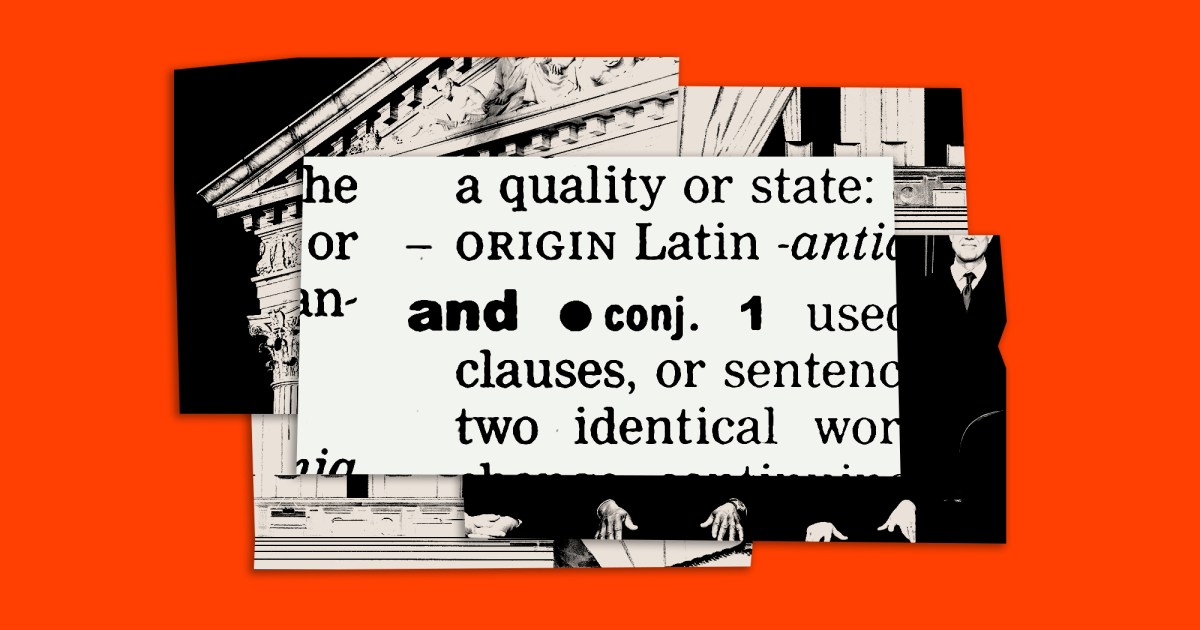“It depends on what the meaning of ‘is’ is.”
I had to Google that one lol. I wasn’t exactly paying attention to politics at that age ig
Ha! was about to comment that very quote.
While funny, the question they asked Clinton was weird as fuck.
“Is there a relationship with Ms. Lewenski?”
Yeah, that was weird indeed. For a panel looking to get to the truth, they could have asked “Do you have a relationship with Ms. Lewinsky?”
I’m old 😅
Can you explain the reference? Is this a Clinton one?
Edit: never mind. It is.
Well, that depends on what the meaning of “is” is.
I’m glad I’m not the only one that thought exactly this.
This isn’t even remotely ambiguous. The DoJ’s interpretation is correct.
The question isn’t really about the meaning of “and”; it’s about the syntactic structure of the whole section.
A defendant is eligible if they do NOT have (A and B and C). In other words, having any of A, B or C will disqualify them.
The law could have been written in a more readable fashion, for example:
the defendant—
- (A) does not have more than 4 criminal history points…;
- (B) does not have a prior 3-point offense…; and
- © does not have a prior 2-point violent offense…
But the meaning is the same either way. Amazing that this got to the Supreme Court.
It’s also entirely plausible that this is exactly what was intended when the law was written.
I don’t think that’s right (imo). And does not mean or. And has additional connotations where or is either or. A and B and C equals A+B+C. This does not equal A or B or C which is what the Supreme Court is trying to argue is true, which it’s not.
In Boolean algebraic notation A+B+C literally means A OR B OR C.
I’m aware this isn’t a useful comment with regard to your original point, I just thought the coincidence was too funny to not point out.
Edit: Wait I get it, if you bracket the statements differently (so that “do not have” applies to each one instead of all of them) you get (!A && !B && !C) instead of !(A && B && C). That seems super unintuitive and I can’t believe the majority claimed that there’s no ambiguity, when I feel like they’ve chosen the much less obvious interpretation.
Yeah, I feel like the article should have made reference to De Morgan’s Law in order to explain the two interpretations. That’s the one that says !(A && B && C) = !A || !B || !C, and !(A || B || C) = !A && !B && !C.
In English, there’s no proper grouping operator, so it’s basically it’s a question of whether you distribute the NOT or the AND first over the list.
The Justices are saying that the ambiguity is completely resolved by the way the restrictions don’t make sense if you interpret it the other way. But the underlying assumption there is that the laws of this country are logical, free from needless repetition and contradictory requirements, which is a TERRIBLE assumption. Our laws are at best written by a committee of people not very familiar with the subjects of those laws, and at worst written by scam artists who then paid to slip them under the radar and into the books. They’re full of idiotic errors, deliberate sabotage, and absurdities. That’s the whole reason for the thing about the lenient interpretation, and this decision will change that in a way that gives judges a whole lot of power to do more harm.
I can tell you that as a lawyer whose done a lot of writing on statutory interpretation, I’ve never seen a case make arguments with this sort of notation.
This case seems clear to me.
I wasn’t suggesting the lawyers or the Justices should have talked about DeMorgan’s law, but rather that it would have been a helpful point for Mother Jones to bring up in the article, to make sure people are on the same page about the logic. You’re right that the notation is probably not helpful though.
The actual legal argument is pretty simple. The law as written is maximally lenient, but also not very logically consistent (e.g. the redundancy indicated in the article). So it seems like some kind of error occurred in the law-writing process. The question is whether they actually meant to write it as maximally restrictive or whether they screwed up in some other way. That certainly seems like ambiguity (a stance supported by the evidence that multiple courts decided these cases in different ways), and the prior standard was that in the case of ambiguity, you had to interpret the law to the benefit of the defendants, which here would be maximally lenient, and indeed also as written. The supreme court has basically reversed that, saying that you can interpret it as maximally restrictive as long as you’re pretty sure that’s what they meant to say. That’s a very different standard.
I think this case is maybe the equivalent of that photo of a striped dress that blew up the Internet a few years ago. Nobody thinks it’s particularly ambiguous, but they come to totally different conclusions about what the obvious correct answer is; just because the ambiguity isn’t necessarily obvious to the individual reader doesn’t mean it’s not there.
I would generally interpret a list as a grouping operator in English writing. The “and” is within the group, and in the structure of a regular grouping clause: “a, b, and c”. If you wrote “does not have a, b, and c” it would be an extremely tortured reading to apply “not” before “and”, especially because there are multiple other ways in English you would write that, e.g. “not have a, b, or c” or “not have any of a, b, and c”.
But the underlying assumption there is that the laws of this country are logical, free from needless repetition and contradictory requirements, which is a TERRIBLE assumption.
Yeah, this decision assumes that the people who wrote the laws are very precise in their attention to detail and would never leave in a useless clause, while also being so inattentive to language that they wrote an “or” clause with “and” (or at least didn’t choose a structure that left no ambiguity).
Topping it all off is going through this whole set of trials with a third of them dissenting and saying “there is no ambiguity anywhere in this law”.
I mostly agree with you. The AND was kind of crammed in outside the list too, though; they’d written it as NOT bullet: limit 1, bullet: limit 2, AND bullet: limit 3. Basically I don’t think it’s implausible that they intended it to be maximally restrictive and just screwed that up. I just think that applying the law as though it means that requires interpreting the law differently from how it’s written, and different in a way that harms the defendants, which you previously weren’t supposed to do. Which seems super dumb.
English is not a formal logical language and the word “and” works more distributively when doing negations in a way that formal logical formulas do not because they need to be manipulatable in a consistent manner.
Okay but what’s the point of 1 then if it must be all three as just a 3 point and 2 point automatically add up to 5?
Let’s look at it this way.
Condition 1 is to disqualify anyone with 5 or more crime points.
Condition 2 is to disqualify anyone who has committed any crime that is worth 3 crime points.
Condition 3 is to disqualify anyone who has committed a crime worth 2 points, but only if it is a violent crime.
So basically, they intend for a violent crime worth 2 points to disqualify you, and they intend for any 3 point crime to disqualify you as well. And they intend for having 5 points to disqualify you.
Worrying about the value of added points is missing the point of the wording of the entire set of rules. Especially if there exist crimes worth 1 crime point. There’s a whole range of crimes you can commit and still qualify.
You could commit:
Up to 4 crimes worth 1 point each.
Up to 2 crimes worth 1 point each, as well as one non-violent crime worth 2 points.
And up to 2 non-violent crime worth 2 points each.The point of condition 1 is to put a cap on the amount of crimes worth 1 or 2 points you can commit.
I hope this helped you understand it the way I understand it.
I don’t know, I didn’t write it!
This really rests very heavily on the authors of the law not just fucking up and including a useless clause because they didn’t do math. They would have to be diligent enough that they could never make any errors in content, but not diligent enough to recognize their wording was ambiguous.
Now thinking about it in terms of mathematical logic, the DoJ and Supreme Court‘s interpretations is wrong:
It’s actually a law of logic (https://en.wikipedia.org/wiki/De_Morgan's_laws) that says that:
not (A and B and C)
is equal to
(not A) or (not B) or (not C)
—
In this case:
The defendant is eligible for relief if he does not (A and B and C)
Which is the same as
The defendant is a eligible for relief if he does (not A) or (not B) or (not C)
—
Which is not what the DoJ is saying. The DoJ is saying that
not (A and B and C)
is equal to
(not A) and (not B) and (not C)
You’re missing the grammatical point of a itemised list though. Writing
abc is not
- condition 1,
- condition 2, and
- condition 3.
Reads as the “not” distributing so as to create the full sentence(es)
- abc is not condition 1,
- abc is not condition 2, and
- abc is not condition 3.
In other words, writing this as an itemised list makes it different from writing it as the sentence
abc is not condition 1, condition 2 and condition 3.
Right! I feel like I’m going crazy because I don’t see how can you interpret it the other way!
lower courts were sharply divided on the vital question of whether “and” bundles the conditions—as in, you don’t have (A), don’t have (B), and don’t have ©—which would mean a defendant who lacked any one of these conditions would be eligible for relief. The alternative reading, advocated by the Justice Department, holds that “and” really means “or”—that a defendant who met even one of the conditions would not be eligible for relief
The reporter seems to be getting this totally wrong. It’s like he is saying the exact opposite of what I understand. From my point of view:
If a defendant would be elegible for relief if he lacked any one of the conditions, that is actually interpreting that AND means OR.
If a defendant would be eligible for relief if he lacked all of the conditions, that is interpreting that AND means AND.
If a defendant would be elegible for relief if he lacked any one of the conditions, that is actually interpreting that AND means OR.
When you move the “not” to the inner terms, as you did in this reformulation, it flips the ANDs and ORs. That’s expected. The original, with the “not” on the outside, has the and/or flip in the majority interpretation.
https://en.wikipedia.org/wiki/De_Morgan's_laws
- not (A or B) = (not A) and (not B)
- not (A and B) = (not A) or (not B)
If a defendant would be elegible for relief if he lacked any one of the conditions, that is actually interpreting that AND means OR.
When you move the “not” to the inner terms, as you did in this reformulation, it flips the ANDs and ORs. That’s
https://en.wikipedia.org/wiki/De_Morgan's_laws
- not (A or B) = (not A) and (not B)
- not (A and B) = (not A) or (not B)
Note the crucial difference between writing this as an enumerated list, and writing it as a continuous sentence.
In the former case (used here) the “xyz is not” distributes such that each point on the list can be read as a complete sentence, giving your (correct) interpretation.
What seems to confuse a lot of people is that if you write “xyz is not A, B, and C”, the “not” no longer distributes the same way, and (A, B, and C) is read as a single condition, giving the alternate (incorrect) interpretation.
This was my takeaway as a lawyer. So I’m glad I’m not alone.
A defendant is eligible if they do NOT have (A and B and C). In other words, having any of A, B or C will disqualify them.
The way you say that is using “or”. “Do NOT have (A or B or C)”. This interpretation makes expressing the “and” case in a concise form impossible. We already have linguistic rules to say what you and the majority think this says, and whatever poorly specified grammar Kagan uses to describe her weekend availability (I’d still say “I’m not free on Saturday or Sunday”), this is a legal document, meant to use precise language.
As you point out, there is precise language for the construct they ruled for. It wasn’t used, while what was used is exactly the form you’d use for “and” meaning “and”.
They could have clearly stated, A defendant is ineligible if they have any of the following, (or all of the following, or two of the following, or clearly state the matrix, A or B and C).
List
End of List.
Because in plain English that reads A or B and C. If you’re going to use the word and anywhere in a list like that it needs to be at the end of every line you want included.
This is a very misleading article. A lot of other comments are already touching on the nuance of the argument here, but I just want to break it down the way I understand it.
(Before that, though, I just want to point out that this is a 6-3 decision, but it’s not the usual 6-3, since Kagan and Gorsuch flipped sides. I think that’s telling enough that this isn’t simply a party-lines interpretation.)
It’s not that SCOTUS argued that “and” means “or”, it’s that when you have a statement “a person is eligible if not (a), (b), and ©”, there is ambiguity in the order of operations between “not” and “and”. The statement could either mean
(1) E = !(A and B and C)
or
(2) E = (!A) and (!B) and (!C)
Demorgan’s law says we can rewrite (1) and (2) as
(1) !E = A and B and C
(2) !E = A or B or C
The court went with interpretation (2), not because one is more “correct” than the other. It seems like (2) was chosen because of the two “statutory difficulties” listed in the syllabus of Pulsifer v. United States.
(1) Pulsifer’s reading would render Subparagraph A superfluous because a defendant who has a three-point offense under Subpara-graph B and a two-point offense under Subparagraph C will always have more than four criminal-history points under Subparagraph A. That reading leaves Subparagraph A with no work to do: removing it from the statute would make the exact same people eligible (and inel-igible) for relief. That kind of superfluity, in and of itself, refutes Pul-sifer’s reading. When a statutory construction “render[s] an entire subparagraph meaningless,” this Court has noted, the canon against surplusage applies with special force. National Assn. of Mfrs. v. Department of Defense, 583 U.S. 109, 128. That is particularly true when, as here, the subparagraph is so evidently designed to serve a concrete function. Pp. 15-20.
(2) Pulsifer’s reading would also create a second problem related to Paragraph (f)(1)'s gatekeeping function. The Guidelines presume that defendants with worse criminal records exhibiting recidivism, lengthy sentences, and violence deserve greater punishment. Under the Government’s reading, Paragraph (f)(1) sorts defendants accordingly. When the defendant has committed multiple non-minor of-fenses, he cannot get relief (Subparagraph A). And so too when he has committed even a single serious offense punished with a lengthy prison sentence (Subparagraph B) or one involving violence (Subpara-graph C). Pulsifer’s reading, by contrast, would allow safety-valve relief to defendants with more serious records while barring relief to defendants with less serious ones. A defendant with a three-point offense and a two-point violent offense would be denied relief. But a defendant with multiple three-point violent offenses could get relief simply because he happens not to have a two-point violent offense.
Contrary to Pulsifer’s view, that anomalous result cannot be ignored on the ground that a sentencing judge retains discretion to impose a lengthy sentence. If Congress thought it could always rely on sentencing discretion, it would not have created a criminal-history requirement in the first instance. Instead, it specified a requirement that allows such discretion to operate only if a defendant’s record does not reach a certain level of seriousness. Pulsifer’s construction of Paragraph (f)(1) makes a hash of that gatekeeping function. Pp. 20-23.
In summary, this is a ruling that could have gone either way, and the side the court chose isn’t totally ridiculous.
It is the side of giving fewer people just the eligibility for relief, which is pretty shitty. But if the court was stooping to an argument as bad as the headline made it out to be, IMO we’d have MUCH bigger problems.
Wouldn’t
(3) E = (!A) and B and C
also be a valid Interpretation?
That’s a reasonable interpretation of my simplified statement “a person is eligible if not (a), (b), and ©”, but I purposely kept my simplification all on 1 line to bring down the line count, which was futile in the end anyway :)
A closer simplification to the exact text is:
“A person is eligible if not:
(a);
(b); and
©”
With formatting I think it’s fair to say “not” should apply to all 3 bullet points, but it’s unclear whether it applies before or after “and-ing” the 3 together.
Edit: formatting. Idk if it’s just my lemmy client or if it’s markdown constraints, but if I only put 1 “newline” between successive statements then the newline is ignored and my entire point of putting different things on different lines making a difference is completely sabotaged :)
This is what happens when you write a constitution with ambiguous language. People arguing about semantics rather than implementing solutions. Fuck, they even decided that the “Executive Office of the President of the United States” isn’t actually an “office” even though it literally has “Office” in its title.
Why does this feel like a prelude to the A OR B AND C debate that people have been agitating with on the 14th Amendment.
Current law: A or (B and C) gives us birthright citizenship. Trump interpretation: (A or B) and C, no more birthright citizenship.
Makes Clinton questioning the meaning of the word “is” seem a bit quaint
To be fair to Clinton he was clarifying on the timeframe intended by the statement because tense matters, e.g. “is, but at the time in question or is, as of right now” because English can definitely be ambiguous sometimes
Bill was a lawyer, he out-lawyered the lawyers and they got mad about it.
This harkens back to Bill Clinton’s ridiculous impeachment (looking at you, Bill Barr, Ken Starr, George Conway) and his ridiculous defense, “It depends on what the meaning of ‘is’ is,” in which a very young and naïve woman was the sacrificial lamb.
So I looked it up, and the law appears to be worded like this:
‘‘(1) the defendant does not have—
‘‘(A) more than 4 criminal history points, excluding any criminal history points resulting from a 1-point offense, as determined under the sentencing guidelines;
‘‘(B) a prior 3-point offense, as determined under the sentencing guidelines; and
‘‘© a prior 2-point violent offense, as determined under the sentencing guidelines;’’So let’s simplify this into English. Because the header says that “The defendant does not have” and then has subsections, we will append that idea to the start of each subsection.
The defendant doesn’t have more than four crime points
and
The defendant doesn’t have a 3 point offense
and
The defendant doesn’t have a violent 2 point offense.
Simplifying it down like this makes it seem like the way it is written is the more strict way the supreme court decided on. It sounds like the supreme court is correct in this case, but they don’t know why they’re correct, since their reason is all wrong.
There is no “and” after (A). An “or” is implied, not an “and”
While there’s no ‘and’ after ‘(A)’, it appears that’s the standard format for a list like this. Every list of x, y, and z in this bill is written in the same way. It seems like it’s supposed to be written like you would a list you give in English. There’s a list of conditions under which a prisoner can be transferred to a prison closer to their home when near release time, and the conditions are listed in the same exact way.
‘‘(2) TRANSFER TO INSTITUTION CLOSER TO RELEASE RESIDENCE.—A prisoner who is successfully participating in an evidence-based recidivism reduction program shall be considered by the Bureau of Prisons for placement in a facility closer to the prisoner’s release residence upon request from the prisoner and subject to—
‘‘(A) bed availability at the transfer facility;
‘‘(B) the prisoner’s security designation; and
‘‘© the recommendation from the warden of the prison at which the prisoner is incarcerated at the time of making the request.There’s no way they will allow you to transfer to a prison that has no space for you, so long as you can fulfill both B and C, it’d be physically impossible! It’s clear they intend for you to meet all 3 requirements, just like in the segment being discussed by the supreme court in the article. There’s also like a seven item list of responsibilities the Attorney General has in the bill too, formatted with the same (A); (B); ©; … (G); and (H) format. And there’s no way they let the dude just pick which task from the list he’s responsible for. Once you become familiar with the bill’s format, it’s extremely clear how this is supposed to work.
I feel like that specific issue is pretty cut and dry, but that’s just me.
Replace some and with or in your code and see what happens!
It depends on what you mean by “code.”
Plus given the headline, what do you mean by “and” here?
Oddly, no discussion about any of the debate writers and legislature had about this bill. As a lay person, I can kind of see both sides, would prefer the defendants win, but also feel like the INTENT of this recent law would be easy to find. If the intent was to free loads of people, or only just a few relatively innocent ones… I guess originalism only matters when people have been dead for hundreds of years.
I had the same thought when reading the article. Someone who wrote it is still alive
A conservative is incapable of entering any discussion or debate in good faith. Every word uttered by a conservative is deception or manipulation.
This illegitimate “supreme” court is infested with conservatives and should be disregarded and abandoned until it is corrected.










